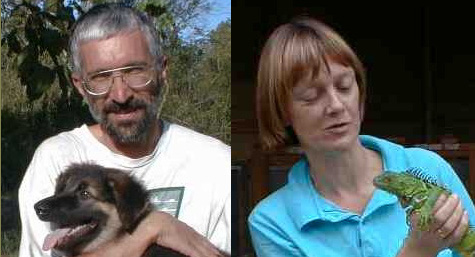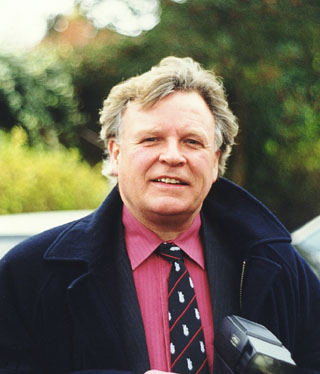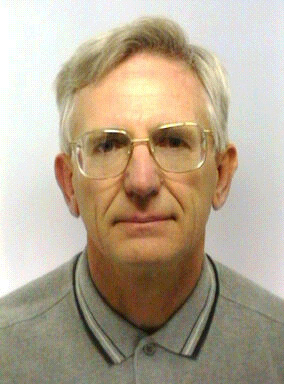FELLOW BELIZE MOTH ENTHUSIASTS
|Back to Introduction|
JAN MEERMAN and TINEKE BOOMSMA
Jan Meerman (left) and Tineke Boomsma come originally from Holland
but have lived in Belize since 1989, when they arrived to manage the Shipstern Nature Reserve and
Butterfly Breeding Centre in Corozal District. In 1995 they moved to the private Slate
Creek Reserve
on the Mountain Pine Ridge road in Cayo District and
established Belize Tropical Forest Studies as a non-profit organisation devoted
to environmental and biological research. Greenhills Butterfly Ranch is maintained by
Tropical Forest Studies as a butterfly breeding and research facility, open to visitors
and
students with an interest in various aspects of Belizean Lepidoptera.
Jan's extensive
work on
Belize butterflies, Hawk Moths and Emperor Moths has seen fruition in the publication
'Lepidoptera of
Belize' published as a special supplement of the journal 'Tropical Lepidoptera'
which represents the most
complete checklist to date of these groups in Belize. As well as managing the day-to-day
running of
Greenhills butterfly ranch Tineke has also made an in-depth study of the Belizean
dragonfly fauna. Jan and
Tineke have published a wide range of faunal and floral inventories resulting from
various environmental surveys around Belize (see 'bibliography'). The webmaster's initial collecting
in Belize was based at Greenhills Butterfly Ranch and both then and since both Jan and Tineke have been
an invaluable source of help and information.
BARRY FOX
Dr. Barry Fox is a freelance ecological consultant specialising in behavioural ecology
of Lepidoptera and is presently producing the Lepidoptera Biodiversity Action Plan
for Hampshire County Council (UK).
His PhD research was a study of the alternative foraging strategies of Ladoga camilla
(Nymphalid butterfly) and Hemaris fuciformis (Sphingid Bee Hawkmoth) on Lonicera
periclymenum
(honeysuckle). In simple plain English (as he puts it) he was "lucky enough to solve the age-old
entomologists' puzzle in the UK as to why camilla only oviposits on shade host
while fuciformis oviposits on the same host but only when it is growing in full sun".
Barry first visited Belize as a member of the British Entomological and Natural History
Society's 1987 expedition to that country, and subsequently spent two extended periods as resident
naturalist and ecological consultant at Pook's Hill Jungle Lodge, where he collected butterflies
and moths extensively. Many of the rarer records of Belize moths appearing on this website
are due to Barry's collecting efforts and the webmaster is grateful to him for his kind generosity
in allowing these records to appear.
NORMAN HALL
Norman Hall was born in 1939 and educated at King Edward’s School, Birmingham, UK,
and Oxford University (Wadham College).
He is now retired after a career with Gillette in Materials Science, Electron
Microscopy and Computing.
A strictly amateur entomologist since 1977, Norman is interested in all families
of moths (Heterocera) with a special interest in Sterrhinae (Geometridae) and Pyralidae.
A long-standing member of the British Entomological & Natural History Society (BENHS),
Norman has served on the Society's Council and was a member of the BENHS Belize
expedition of December 1998 (his only experience to date of the Neotropical moth fauna).
Norman makes regular field excursions (by car) to France and Spain (4-8 weeks annually),
surveying many sites on each excursion, principally by light trapping. He has much
experience of identification in the field; sensible selection of material for collection
and different methods of transporting specimens home, so that all specimens are valuable
, identifiable and in as good a condition as possible. This experience was of great value
in Belize, despite the greater number of species (and the impossibility of identifying
most material in the field on a first visit).
The webmaster is extremely grateful to Norman for allowing him to study his fine collection
from Belize and for helping extensively with identifications.
|Back to Introduction|



